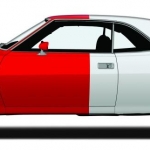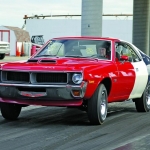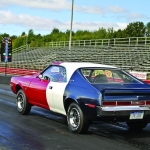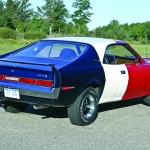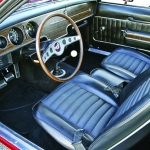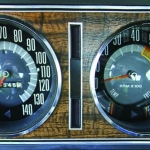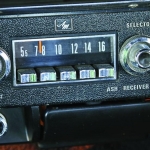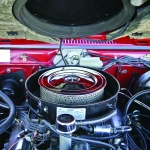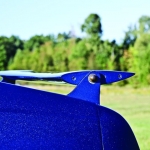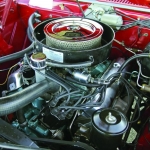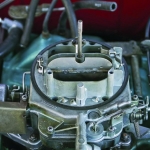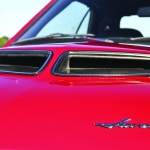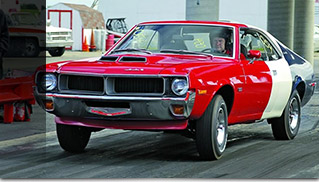 When used in motorsports, it means to give official recognition to a prototype car or car component, thus allowing it to be used in a race. During the Sixties, homologation rules created by NASCAR, NHRA and SCCA inadvertently created what turned out to be some of the most sought-after street-legal cars to ever leave the assembly line, typically featuring very particular blends of high-performance componentry under the hood, as part of the chassis, incorporated into the body work, or perhaps all of the above. Among these “homologation specials” were Dodge Daytonas and Plymouth Superbirds, Ford Talladegas and Thunderbolts, Camaro Z/28s and Boss 302 Mustangs, to say nothing of Chrysler’s Street Hemi and Ford’s Boss 429 engines. AMC needed a player of its own in this automotive chess match, and found it in the 1970 Trans-Am Javelin.
When used in motorsports, it means to give official recognition to a prototype car or car component, thus allowing it to be used in a race. During the Sixties, homologation rules created by NASCAR, NHRA and SCCA inadvertently created what turned out to be some of the most sought-after street-legal cars to ever leave the assembly line, typically featuring very particular blends of high-performance componentry under the hood, as part of the chassis, incorporated into the body work, or perhaps all of the above. Among these “homologation specials” were Dodge Daytonas and Plymouth Superbirds, Ford Talladegas and Thunderbolts, Camaro Z/28s and Boss 302 Mustangs, to say nothing of Chrysler’s Street Hemi and Ford’s Boss 429 engines. AMC needed a player of its own in this automotive chess match, and found it in the 1970 Trans-Am Javelin.
It was hard to miss the new AMC model. Prominent two-page ads in countless contemporary magazines featured Peter Revson’s factory red/white/blue Trans-Am Javelin alongside a street equivalent finished in a matching paint scheme, sans numbers. Included were front and rear spoilers, five-spoke wheels, a hood scoop and a 390-cu.in. engine, as well as a four-speed, as standard equipment. It was also costly: The MSRP was nearly $4,000, which was only part of the reason just 100 were to be built in September and October of 1969. Without question, it had the vibe of a street-legal race car, appearing every bit the homologation special if ever there was one. Yet in this case, the term is actually something of a misnomer.
By the late Sixties, SCCA’s Trans-Am rules regarding the topic were in constant flux and, truth be told, not completely consistent from one car, or even car part, to the next. The reality was that the new Trans-Am Javelin, assembled from the SST, was an effort by AMC to promote its commitment to the race series while generating interest at the dealership.
If homologation rules were being considered, as has often been speculated, then the Trans-Am Javelin might have come with some form of special equipment, perhaps including a special variety of the 304 engine, rather than the 390. It could be that the scooped hood borrowed from the AMX was part of the plan, but its inlets had to be blocked on the actual race cars per SCCA’s rules. The adjustable rear spoiler? The real race cars used the ducktail that was part of the other special Javelin for 1970: the Mark Donohue edition, conceived after he and Penske signed a three-year deal with AMC. The 2,501 Donohue editions, released mid-year, were sufficient enough to exceed the revamped-for-1970 SCCA homologation rule by a single car.
Regardless of old rumors and sometimes foggy SCCA Trans-Am rules, the tri-tone Trans-Am Javelin is a bona fide factory rarity among its race-inspired peers of yore. Effectively the least-known model from the original Trans-Am era, it offers competitive horsepower and handling characteristics, but unlike its Detroit rivals, the entry fee for today’s aficionados is considerably more affordable, and by a very wide margin in some cases. Sound enticing? Here are some more details to digest while pondering ownership possibilities.
ENGINE
As mentioned above, the Trans-Am Javelin came equipped exclusively with AMC’s 390-cu.in. engine. Introduced for the 1968 model year, engineers of AMC’s second-generation V-8 took into account future expansion, therefore ample room was provided for the 390’s large 4.165-inch cylinder bores. Pistons travelled 3.574 inches, linked to the forged-steel crankshaft via forged-steel connecting rods.
Originally rated for 315 horsepower, the 1970 edition found in each Trans-Am Javelin received slightly altered cylinder heads. Made of cast iron and utilizing 2.02/1.625-inch intake/exhaust valves, each of the rectangular exhaust ports received a slight “dog leg” that served to improve flow. Although the compression ratio was lowered from 10.2 to 10.0:1, the 390 was now officially rated for 325 hp @ 5,000 RPM, and 420-lb.ft. of torque at 3,200 RPM.
The Trans-Am package also mandated the installation of a heavy-duty cooling system and the otherwise optional, yet always desirable, Go Package. Along with a full dual-exhaust system to further enhance breathing, the package capped the cast-iron intake manifold with a Motorcraft 4300 four-barrel carburetor and AMC’s Ram induction system, consisting of ducting that sealed the open-element air cleaner assembly against the functional split hood scoop above.
A sound engine generally, American Motors Owners club technical editor Jeff Reeves stated in a previous interview that its one drawback was its oiling system, which restricted flow during extreme use such as drag racing. However, race engine builders developed a now well-known oiling modification that greatly relieves the problem. Like other engines, the AMC 390 can be rebuilt with relative ease. Everything from tune-up kits to pistons are readily available, while aftermarket suppliers offer camshaft, intake manifold and even aluminum cylinder-head upgrades that can enhance power ratings.
TRANSMISSION
Following the lead of some of its competition, AMC fitted just a single transmission into the Trans-Am Javelin: A Borg-Warner T-10 wide-ratio four-speed manual, complete with a Hurst Competition shifter, unhampered by a clunky floor console. Look for a T-coded tag attached at the rear of the case. First-through-fourth gearing is 2.64, 2.10, 1.60 and 1.00:1. The decision to add the unit as standard equipment served two purposes: It eliminated a potential complaint from the road test critic’s checklist during the escalating muscle car movement and further intensified the intended race-car vibe.
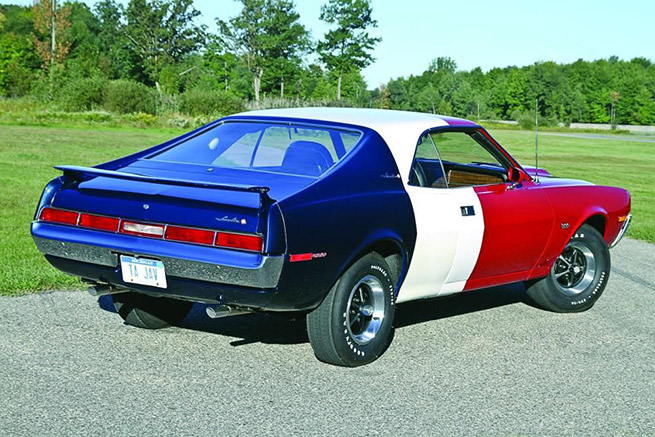
The Borg-Warner T-10 is stout enough to handle the torque supplied by the 390; however, long-term abuse and frequent quarter-mile power shifts can wear internal components. Like other mass-produced transmissions, rebuild kits are readily available, and the procedure is fairly straightforward. If needed, numerous specialists exist to assist in T-10 rebuilding.
DIFFERENTIAL
After being transferred through the four-speed, engine torque was fed through AMC’s Model 20 differential, containing an 87⁄8-inch ring gear, to the rear axles. Unlike the rest of the Javelin lineup, the Trans-Am package mandated the Twin-Grip positive traction system and a 3.91:1 final-drive ratio instead of the otherwise standard 3.54 gear. In theory, dealers, via the High-Performance Group 19 parts catalog insert, could have installed one of three race-friendly ratios–4.10, 4.44 and 5.00:1–upon customer request.
The Model 20 was used throughout AMC’s V-8 engine production–its last appearance came in 1979–and durability is nearly a non-issue when used with stock engines. The lone exception is the splined hub on the end of each axle shaft. According to Jeff Reeves, though, if they are properly torqued on a regular basis, then even extreme engine forces should not be a concern. If regular performance driving is your plan, then you may want to consider replacing the splined shafts with aftermarket, solid one-piece units.
CHASSIS
AMC engineers designed the 109-inch wheelbase Javelin as a unit-body platform that initially employed trunnions in the front suspension at the front spindle’s upper pivot point; however, for 1970, AMC made the switch to upper ball joints, with an upper and lower control arm/coil spring arrangement similar to that of Ford’s Mustang. Semi-elliptic rear leaf springs located the rear axle. This is another area in which the mandatory Go Package had an effect on the Trans-Am Javelin’s build traits, as it automatically upgraded the chassis to include the Handling package, comprised of heavy-duty components. Another option, power steering, was also mandated by the Trans-Am package.
BRAKES
Drum brakes may have been the norm throughout the industry at the time; however, the Go Package mandated the installation of front power disc brakes on the Trans-Am edition. The front rotors measured just shy of 11 inches in diameter and were accompanied by four-piston calipers. Standard 10-inch diameter drums completed the brake system, along with a now-standard dual-circuit master cylinder.
WHEELS & TIRES
Each of the Trans-Am editions were furnished with racy 14 x 6-inch AMC Magnum 500 five-spoke wheels–plus one space-saver in the trunk. Although the Go Package would have regularly mandated E70-14 red line bias-ply tires, they were set aside in favor of the more aggressive Goodyear Polyglas F70-14s with raised white letters that originated, fittingly, in the manufacturer’s Speedway Wide Tread series. Today, OE replacement tires can be obtained for roughly $240 each. It’s more likely you’ll find an example fitted with modern radials, as they tend to offer better drivability at a more affordable price per set.
BODY & INTERIOR
In spite of the cost involved in converting the 100 Javelin SSTs into Trans-Am editions–lore has it that Kenosha actually lost money in spite of its high MSRP–AMC put more forethought into the process than the earlier 52-unit SS/AMX drag racing conversions, which were done by an outside vendor. Instead, the Trans-Am conversions were done in-house in batches dictated by available floor space.
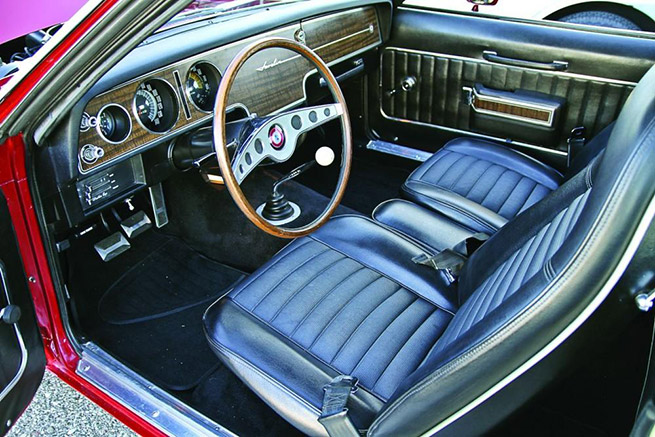
Each started life as a standard SST finished in Frost White with its bucket seat interior–complete with center cushion and fold-down armrest–shod with black vinyl upholstery. The Trans-Am package deleted the standard wheel-opening paint stripes and rocker panel trim, which paved the way for the custom tri-tone paint resembling the factory team scheme. Matador Red was applied to the front section of the car, while Commodore Blue was applied to the rear; the mid-section remained Frost White. Rather than cover just the skin, the paint was carefully applied throughout the body, meaning inside egress points and portions of the undercarriage. To indicate the paint scheme, door tags were stamped with a “00” paint code.
Standard Javelin SST badging was retained; however, color-keyed front and rear spoilers from the Group 19 insert were required, both of which were originally engineered by Ronnie Kaplan, who was head of AMC’s factory Trans-Am team from 1967-’69. The rear spoiler is a three-piece unit consisting of fiberglass and machined aluminum. Like the spoiler fitted on the actual pre-1970 race cars, it is adjustable; however, the lateral blade–in most cases–can be seen secured in a front-to-rear horizontal plane as it is more aesthetically pleasing. It has been suggested that not every front spoiler was installed at the assembly line, for fear of it being damaged during shipping. If this were indeed the case, they surely would have been installed by the dealer.
Interiors did not receive any special badging or color patterns. Other than the already discussed seating, the standard SST woodgrain dash was furnished with a 140-MPH speedometer and an 8,000-RPM tachometer, as mandated by the Trans-Am package. Within the tach were small temperature and fuel gauges, as well as discrete amp and oil pressure warning lamps. A two-spoke Rim-Blow steering wheel, AM radio, Visibility and Light Groups were mandated as well.
In a previous interview, Eddie Stakes of planethoustonamx.com commented that those considering the purchase of a Javelin of this era–including the Trans-Am edition–should inspect the quarter panels, the sill panel between the rear window and trunk lid, and the lower portion of each A-pillar. Panel designs led to poor drainage if debris was permitted to accumulate in these areas. Trunk and floorpans should also be inspected.
RESTORATION & PERFORMANCE PARTS
AMCs have always enjoyed a strong following, though parts availability has long been a challenge. However, as their popularity continues to gain momentum, more restoration parts have become available as existing NOS part supplies dwindle. Floorpan sections, rocker panels, trunk pans and patch panels for the rear quarters are readily obtainable, and although some fiberglass panels that cross the Javelin/AMX lines are now offered, most owners prefer steel while restoring their Trans-Am Javelin due to its rarity. Used panels in good condition still exist, although even this supply is shrinking. The list of interior replacement parts continues to grow as well, while mechanical components have never really been in short supply. Original AMC High Performance Group 19 parts can be found, but are exceedingly rare. That said, the front and rear spoilers are reproduced, while items such as performance camshafts, aftermarket intake manifolds and cylinder heads can spice up the AMC’s performance.
1970 AMC Javelin Trans
Source: www.hemmings.com
